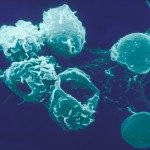Link to Pubmed [PMID] – 17350019
Int. J. Parasitol. 2007 Jul;37(8-9):963-73
Pathogenic CD8+ T cells are implicated in the physiopathological mechanisms leading to experimental cerebral malaria (CM) in Plasmodium berghei ANKA (PbA) infected mice. Therefore, we hypothesised that in CM susceptible mice the neuropathology could be, at least in part, the result of an inefficient control of pathogenic effector T cells by CD4+ CD25+ Treg cells. Remarkably, the number of CD4+ CD25high T cells expressing Foxp3 increased in the spleen during the course of infection. These cells displayed an activated phenotype and consistent with that, CD4+ CD25high Treg cells isolated from PbA-infected mice showed an enhanced regulatory activity in vitro. Surprisingly, these cells do not migrate to the brain at the time of neurological symptoms as the conventional CD4+ T cells do. CM was not exacerbated in anti-CD25 treated mice when infected with PbA one month after treatment, even if splenic CD8+ T cells expressing CD69 increased in these mice. Taken together, these results show that P. berghei infection leads to an increase of the number of splenic CD4+ CD25high Treg cells exhibiting in vitro suppressive function, but they do not seem to be involved in vivo in the protection against CM.



